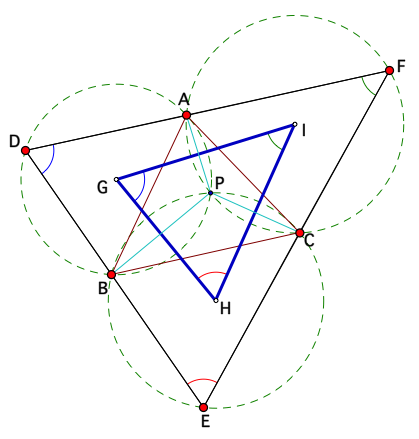
NOTE: Please WAIT while the applet below loads.
Generalization 1: If similar triangles DBA, BEC and ACF are erected on the sides of any triangle ABC, and G, H and I are in the SAME RELATIVE1 position to these triangles, then they form a triangle GHI similar to the three triangles.
Footnote: 1) If two triangles ABC and A'B'C are directly similar, then the point P' is in the same relative position to ΔA'B'C as P is to ΔABC if the transformation (in this case a translation or a spiral similarity) which maps ΔABC to ΔA'B'C, also maps the point P onto P'.
Napoleon Generalization 1 (1995)
*****
Generalization 2: If triangles DBA, BEC and ACF are erected on the sides of any triangle ABC, so that ∠D + ∠E + ∠F = 180o, and G, H and I are the circumcentres, then ∠G = ∠D, ∠H = ∠E, and ∠I = ∠F, and the three circumcircles of the three triangles are concurrent.
Important: To view & manipulate the dynamic version of this 2nd generalization, navigate to it using the appropriate button in the ABOVE dynamic sketch; the picture below is static.

Napoleon Generalization 2 (1967)
Explore More
a) Using Napoleon Generalization 2, find a different arrangement to the 3 similar triangles in Napoleon Generalization 1, for which the circumcentres would also give GHI similar to the 3 similar triangles.
2) To view & manipulate a dynamic version of another arrangement of three similar triangles on the sides for which GHI is similar to the three outer triangles, navigate to 'Similar Triangles Variation' using the appropriate button in the dynamic sketch right at the top.
Note: While it's nice to prove Generalization 2 (and its Similar Triangles Variation versions) with theorems from circle geometry, the result about ΔGHI follows directly from Pompe's Hexagon Theorem (2016). Note that even though the latter theorem by Pompe doesn't directly prove the concurrency of the circumcircles, it can easily be derived from it as a corollary.
*****
A special case of Generalization 2: Miquel's Theorem: If the vertices of triangle ABC lie, respectively, on sides DF, DE and EF of ΔDEF, then the three circumcircles ADB, EBC and FCA are concurrent, and triangle GHI is similar to ΔDEF.
Important: To view & manipulate the dynamic version of Miquel's Theorem, navigate to it using the appropriate button in the dynamic sketch right at the TOP; the picture below is static.

Napoleon Specialization (1967): Miquel's Theorem
Historical Note: This theorem was originally discovered by Miquel in 1838, and is sometimes also called the "Pivot" theorem. It's also easy to prove independently without the use of the above Generalization 2 of Napoleon.
References
i) Coxeter, H. & Greitzer, S. (1967). Geometry Revisited, pp. 61-65.
ii) De Villiers, M. & Meyer, J. (1995). A generalized dual of Napoleon's theorem and some further extensions. Int. J. Math. Ed. Sci. Technol., 26(2), pp. 233-241.
iii) De Villiers, M. (1996). Some Adventures in Euclidean Geometry, pp. 177-179.
Some Other Papers
John Rigby from the Math Dept, Cardiff University creatively uses tessellations in his 1988 paper Napoleon Revisited in the Journal of Geometry to prove Napoleon's theorem as well as some of the above generalizations.
Martini, H. & Weibbach, B. (1999). Napoleon's Theorem with Weights in n-Space. Geometriae Dedicata, 74, pp. 213–223.
Boutte, G. (2002). The Napoleon Configuration. Forum Geometricorum, 2, pp. 39-46.
Van Lamoen, F. (2003). Napoleon Triangles and Kiepert Perspectors. Forum Geometricorum, 3, pp. 65-71.
In a 2017 paper A generalization of the Napoleon's Theorem in Mathematical Reflections, no. 3, Khakimboy Egamberganov generalizes Napoleon's Theorem even further, and applies it to solve several interesting Olympiad type problems, including Pompe's Hexagon Theorem. In addition, Egamberganov's Theorem is a lovely generalization of Generalizations 1 & 2 above as well as of the Similar Triangles Variation Generalization.
Explore More
For other generalizations & variations of Napoleon, including Fox's theorem, and more on Egamberganov's Theorem, see Related Variations & Generalizations of Napoleon's Theorem.
Related Links
Some Circle Concurrency Theorems
Pompe's Hexagon Theorem
Bride's Chair Concurrency & Generalization
A variation of Miquel's theorem and its generalization
Fermat-Torricelli Point Generalizations
Weighted Airport Problem
Some Variations of Vecten configurations
Free Download of Geometer's Sketchpad
Back to "Dynamic Geometry Sketches"
Back to "Student Explorations"
Created in 2008 by Michael de Villiers, updated to WebSketchpad, 5 April 2020; updated 20 August 2024.